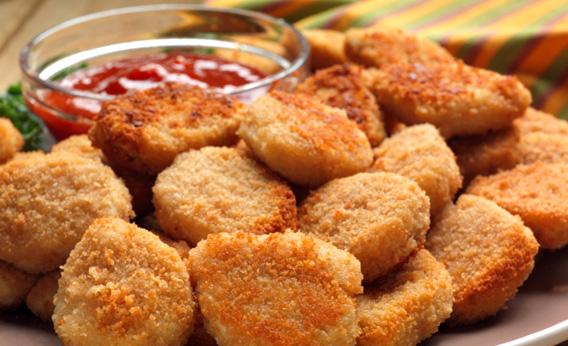 We know almost everything about chicken nuggets, except who is responsible for them
We know almost everything about chicken nuggets, except who is responsible for them Photograph by Jack Puccio/iStockphoto/Thinkstock.
We think we know the chicken nugget: small, salty, and spongy, derided by Michael Pollan and reviled by Jamie Oliver, who recreated them on camera by whizzing a chicken in a food processor and forcing it through a sieve. We know that children adore them, that parents are conflicted about them, that public-health campaigners despise them for sparking an epidemic of obesity. We know we can?t get away from them: There are nuggets at almost every fast-food chain, on almost every restaurant kids? menu, and in almost every supermarket freezer: breaded or naked; fried or grill-marked; gluten-free or organic; shaped like alphabets, dinosaurs, or stars.
We know almost everything about chicken nuggets, except who is responsible for them.
Credit, or blame, usually goes to McDonald?s, which sold its first McNuggets in 1980. But the probable inventor of the nugget is a Cornell University professor named Robert C. Baker who died in 2006, and who proposed a prototype?a frozen, breaded ?chicken stick??in 1963.
Baker was a professor of poultry science, and a chicken savant. He and his graduate students dreamed up the first versions of products we now take for granted: chicken hot dogs, chicken cold cuts, chicken meatballs, and more than 50 other edible items made from eggs and chicken but made to look like something else.
The foods they invented, which they detailed in widely distributed bulletins for anyone to copy and refine, launched what the industry now calls ?further processed? poultry. Convenient and appealing, further-processed products transformed the market for chicken, pushing consumption from 34 pounds per person in 1965 to 84 pounds last year. But pressure from that new demand transformed the industry as well, turning it from a loose confederation of many family farms into a small set of massive conglomerates with questionable labor and environmental records.
It?s a mixed legacy for a man who wanted only to increase the market power of upstate New York?s poultry farmers?men whose families have since left the business, because the changes wrought by nuggets made it unprofitable. ?I think you have to understand him as a person of his time,? Baker?s oldest son Dale, now 66, told me. ?He grew up in the Depression, not having enough food to eat. When he?d buy a dinner, he would want to get the most calories for the price. He wanted to be sure the farmers would get the best prices for their birds.?
The accepted history of the chicken nugget is told, with slight differences, in The Omnivore?s Dilemma, Fast Food Nation, and Behind the Arches, a 1986 chronicle of McDonald?s that the corporation cooperated with (and sent me, when I asked them for comment). The origin story goes like this: McDonald?s began with burgers, of course. But in 1977, the federal government?s first-ever dietary guidelines urged Americans to eat less fat, and especially less red meat. Burger sales dropped, and McDonald?s began looking for an alternative that would keep customers loyal. Its executives thought their best chance lay in chicken, the lower-fat protein that Americans were choosing instead, and the company plunged into intense product research, even hiring a European chef who had cooked for the Queen of England to contribute ideas. Test customers spurned one attempt, an experimental chicken pot-pie; the next idea, bone-in fried chicken, veered too close to the existing menu at rival KFC.
McDonald?s founder Ray Kroc ordered the chef, Rene Arend, to work on yet another product?deep-fried onion chunks, easier to mass-produce than rings?but was countermanded by the company chairman, Fred Turner. Turner still wanted something made from chicken, and he steered the chef to chicken chunks instead. Arend boned a chicken breast, cut it into small pieces, battered and fried the bits, and served them with a sauce. They were a hit within headquarters, but too labor-intensive to make on an industrial scale.
McDonald?s recruited corporate partners into a secret development campaign, calling on???? frozen-hamburger supplier Keystone Foods to mechanize chicken-chopping and fish-stick popularizer Gorton?s to perfect a coating that would cling. McNuggets debuted without advance warning in 15 Knoxville, Tenn., McDonald?s restaurants in March 1980 and blasted through the stores? sales records. Word of the new product spread so quickly among franchisees that Keystone built a processing plant in 100 days to keep up with the expected demand. When they rolled out nationwide in 1981, McNuggets became a cultural juggernaut.
What this story leaves out is that, 18 years earlier, Baker had come up with the same concept, for different reasons.
Baker grew up on a small fruit farm a few miles from Lake Ontario, and seems to have planned to go into the family business: His bachelor?s degree, from Cornell, was in fruit agriculture. He aspired to be a Cornell professor, but his widow, Jacoba, remembers his mentors advising him to work somewhere else first. He took a position as a cooperative extension agent?a liaison between land-grant universities and local communities. After earning a master?s in marketing at Penn State, Baker went to Purdue University for a Ph.D. in food science. He joined the Cornell faculty in 1949, and set up a poultry-products technology lab 10 years later.
Source: http://feeds.slate.com/click.phdo?i=b57a22791757b94b4790626a8643a780
freddie mac kristin cavallari oscar nominations rough riders joy division norco rand paul detained
No comments:
Post a Comment
Note: Only a member of this blog may post a comment.